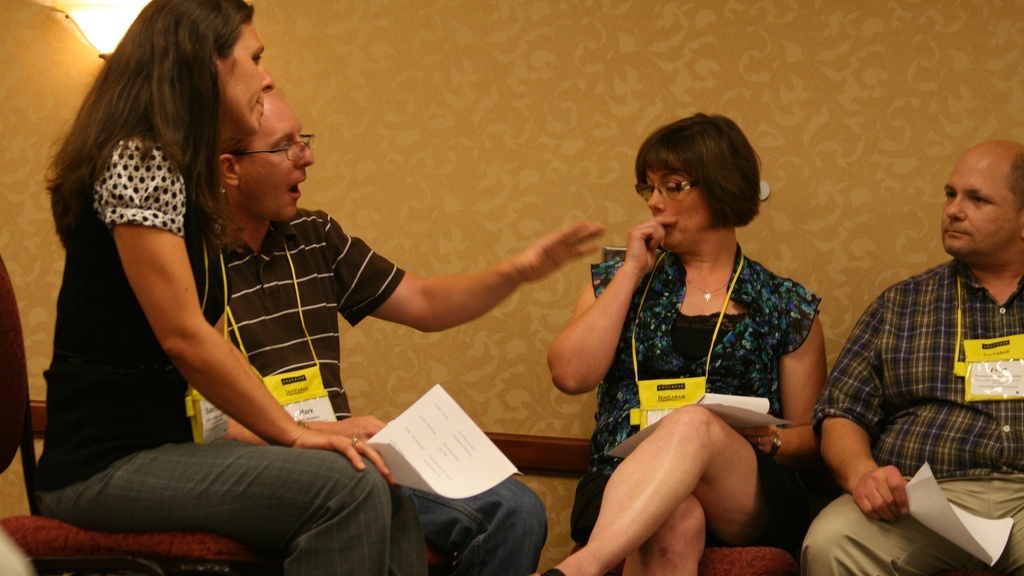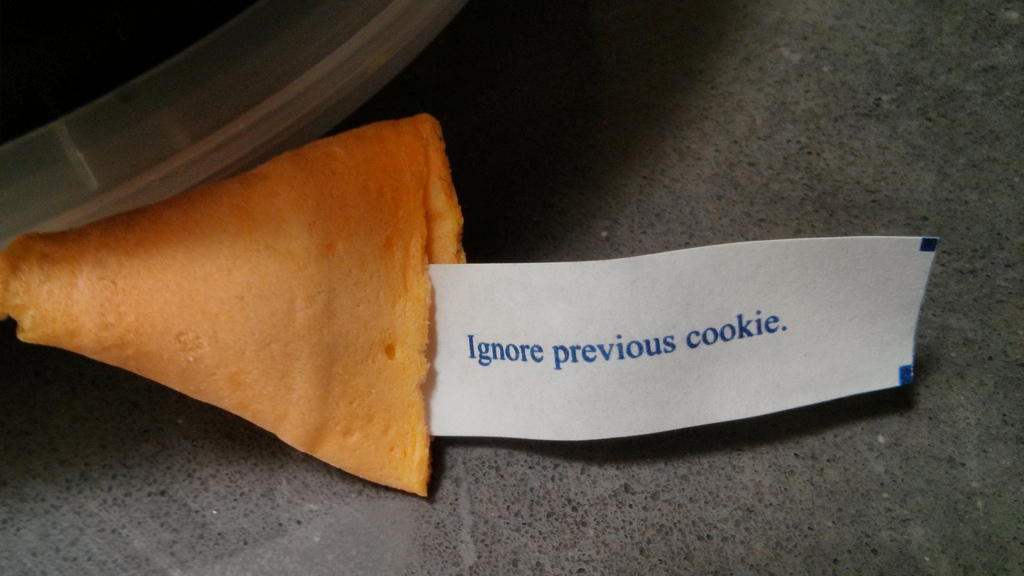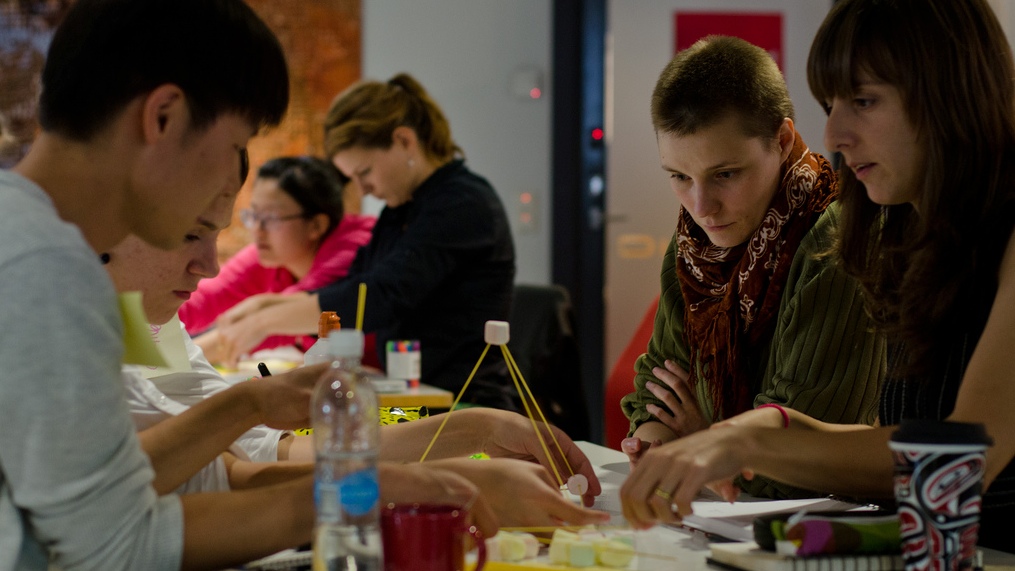I’ve always been fascinated with how some teams work well together and how some managers get great results, but what is it that makes a team excel? In my experience as an employee and now as a manager, I’ve tried to pinpoint how to create an efficient and effective team.
Image by Sentavio (Shutterstock). Photos by Nathan Siemers, Quinn Dombrowski, Simon Blackley, Peter, Mackenzie Black, Creative Sustainability, Martin Fisch (Flickr).
Chalk me up as one of those people who is obsessed with clear communication, fascinated with the different ways people articulate their concerns to one another, and in particular the way great managers get great results from great people.
I’ve been on both sides of the management coin — both being told what to do and now managing others. Currently, I’m CEO of UpdateZen, and in the past, I’ve reported to a CEO. And in my role as product manager for UpdateZen, I’ve also done extensive customer outreach to executives, managers and team members of all stripes. And what I’ve found is that at the nexus of great management and teamwork lie seven simple truths — or golden rules — about how to effectively and optimally manage great people.
I’m approaching this from a management perspective, but the rules apply to any type of collaboration and teamwork. Let’s dig in.
Golden Rule #1: Treat Everyone With Respect

Sounds obvious, but you’d be surprised. In any event, great management and teamwork starts here. If someone reports to you, you are now responsible for both their work productivity and their contribution to your company’s culture. Aside from the fact that you should treat people respectfully simply because it’s the right thing to do, let’s focus on why it’s good business to treat your people with respect at all times.
In short, when you treat people with respect, they end up liking you more. Fancy that. And if they like you, they will want to help you achieve your goals. And if they want to help you achieve your goals, they will work harder for you, they will work smarter for you, they will be more productive, and not unimportantly, they will be far less likely to jump ship when the going gets tough. When you’re building a team or company, you simply can’t afford to lose great people. Treat them with respect and you’re one step closer to keeping them on your team long-term.
Golden Rule #2: Encourage Dissent

What? That’s right… encourage your team members to speak up and disagree with you when they genuinely feel differently about something important.
I always try to hire people who think for themselves, who push the envelope, and who come up with creative ideas that I never would have thought of. I do this knowing full well that people of this type also have a higher likelihood of becoming, shall we say, troublemakers. But it’s a risk worth taking. While toxic troublemakers can’t be tolerated on a team, there is a particular strain of trouble-making that is not only healthy, but very much required if you are managing a team or company that is trying to grow bigger and better.
In all “knowledge” businesses, you need people executing creatively at the highest level. And to do great things, you and your people need to consistently think outside the box. You need people who feel very comfortable disagreeing with you, trying new things, tossing out new ideas, and being ok with the fact that several of their ideas may turn out to be outright awful. But some of those ideas will succeed, and succeed wildly, and in order to cultivate an environment where your team members’ best ideas surface, you need to make sure everyone on your team knows that you’ve got their back when their not-so-great ideas fail, and fail wildly.
You might feel like you’ll surely have some great ideas yourself, but if you’re able to yourself with “A” players, then you know that your people will often have even better ones. Which is why you should encourage them to express their disagreements. I encourage my people to fight for their ideas if they feel strongly about them. I want them to make a cohesive, articulate, impassioned case for why their idea is worth pursuing, investing in, or executing. I don’t want them throwing crap against the wall and seeing what sticks. I want them to do a deep dive and really formulate a strong case for their idea.
There are two simple truths here:
- People feel more empowered if they’re encouraged to contribute their own ideas. They feel more ownership if their team ultimately incorporates some of their ideas. People rightly feel that their contributions are unique to them, and therefore, when their ideas are implemented, they feel more ownership in their team’s success. Nothing should be held in higher regard.
- I want the best ideas out there. I don’t care where those ideas come from. In fact, nothing makes me happier than for one of my team members to not just come up with a better idea than mine, but to outright prove me wrong. I love being proved wrong. First, it means I’ve learned something. And second, it means I have surrounded myself with people smarter me and successfully encouraged them to think freely and speak their mind.
Golden Rule #3: Make The Final Decision And Move On

If you are the manager, it is incumbent upon you to make final decisions, and to do so decisively. So while I encourage dissent among my team, when it comes decision-making time, it’s up to me to evaluate all the options in front of me, hear and absorb everyone’s arguments, and ultimately make the final call. And when I do, I’ll always articulate to my team why, and then move on. Even if you’ve expressed dissent as an employee, it will benefit you to let you manager make their call and then focus on what’s next, rather than stay mired in the past.
Some decisions are difficult, of course; here are three that I often face when making a decision:
- When I’m facing a difficult decision, leaning strongly in one direction, and everyone agrees, great. Easy decision.
- When I’m facing a difficult decision and I’m leaning strongly in one direction, but there is a strong dissenting opinion from one or more team members, I’ll urge them to convince me otherwise. I’ll hear them out and strongly consider their reasoning. But if after that, I’m still leaning strongly in the same direction I was, I’ll go with my gut.
- When I’m facing a difficult decision, and I don’t feel convincingly one way or the other, I’ll not only ask my team members for their recommendation, but I’ll often ask them how strongly they feel about the issue. Sometimes I’ll even ask them to put a number on their conviction. “On a scale of one to ten, how strong is your conviction?” If they give me a six, a seven, or even an eight, I’ll duly note it, and likely go with my gut. But if a great team member rates her conviction a nine or a ten, I will almost invariably decide in favour of her conviction.
Remember, as a manager it is your responsibility to do what you think is best when facing key decisions. That is your job. If you ultimately decide that your impassioned team member is wrong about something and you’re right, then it is incumbent upon you to make the final decision and go with your gut. And when you do, be decisive, be clear, explain your decision… and then move on.
Once a decision is made, your impassioned team members need to listen to your decision and carry it out, but perhaps most importantly, treat it as if it were their idea, even when they disagree. No passive-aggressiveness allowed. If I smell even a hint of passive-aggressiveness, I’m done. I welcome and encourage dissent in my team and we’ll respectfully debate the issue as long as is warranted, but as a manager, once I’ve made a final decision, we both need to move on, and you need to get behind the decision, genuinely.
It’s the same if you’re on the receiving end of a decision that you don’t quite agree with; the decision’s been made, so find a way to move forward.
Golden Rule #4: Always Give Them A “Why”

Old-school management thinking was typically more iron fist; you ask an employee to do something, and if they ask why you might just say “because I said so.” The employee begrudgingly does the work.
Maybe that works with your children , but it will surely backfire with your team members. Your team members need to know that they are part of a larger purpose. They need to know that whatever task they’re doing ties into the larger company goals. They need to know that their work matters. I can’t overstate this. If you believe that a motivated and happy employee is a better employee, then take the time to explain to them why you are asking them to do something, rather than just asking them to do something. And when making a difficult decision, explain to them why you are making a certain decision rather than just informing them of the decision.
Plus, you can’t be — nor should you be — beside your team member every second that they are working on a project, right? They will be making macro- and micro-decisions throughout any given project. If you want them making optimal decisions at optimal times, arm them with the why. The project will get done faster, better, more efficiently, and with fewer revisions than if you don’t arm them with the why.
Golden Rule #5: Keep Your Communications Short

In management and communication, the benefits of brevity so outweigh the benefits of verbosity that it must be included in these golden rules of management and collaboration.
When you task one of your team members with something, it’s paramount that the communication is crystal clear, right? They must understand exactly what they need to do, and why. And if it takes you too long to explain something, it’s probably because you haven’t first taken the time to distil it down to its core essence. If you’re a manager, this is your responsibility; say what you need to say as efficiently as possible. Sure, give your team members some colour, some background, and certainly any necessary context. But the more efficient you can be in communicating what needs to get done to your team, the more likely they will know in no uncertain terms what is expected of them and why.
Once you’ve been given an assignment or tasked your team with one, it’s then incumbent upon the person responsible to update the manager as efficiently as possible throughout the execution of the project. Encourage them to take the time to distil their project updates down to the core essence of what you need to know, and just as importantly, encourage them to leave out what you do not need to know. They shouldn’t waste their time writing verbose, two-page, single-spaced status updates, and they sure as heck shouldn’t waste your time by asking you to read them.
Be aware that brevity can sometimes be confused with curtness. Some people are still figuring out email etiquette so be careful not to accidentally seem rude when you’re just trying to be brief.
Golden Rule #6: Remove Toxic Troublemakers Promptly

Not all of you are in a position to fire people or change your team, but when someone isn’t carrying their weight or is causing unneeded chaos, you need to try to remove them.
I have managed my share of troublemakers in the past, even in the very recent past. And truth be told, I’ve been managed by troublemakers, too. I previously explained that there is a certain strain of “trouble-making” that is absolutely essential for a healthy, successful company that wants to grow. But there is also a strain of trouble-making that is absolutely unacceptable, and I’m talking about people whose personality or actions can be described as disrespectful, toxic, disloyal, and ultimately counterproductive to your team’s goals.
If you have a toxic personality on your team, get rid of them as soon as you can. You will never regret it. If they’re not right for your team, there’s probably no way around it but to remove them. And guess what? They probably know that they aren’t an ideal fit. More importantly, the rest of your team probably feels the same way. It’s unfair to your truly great team members if you keep a personality on board who is inhibiting their ability to work. And if you don’t have the authority to change your team, talk with someone who does and clearly communicate the problem.
Golden Rule #7: Make It Fun

If you’re in a knowledge business, then you put a premium on your team members’ thoughts and thinking. And you acknowledge that their passion, creativity and self-motivation are more important than anything else. And I sure hope you also know that your best team members have more career options than you can shake a stick at.
So guess what: you better make it fun to work with you. And I’m not talking about going out for drinks after work, or bringing in sushi for lunch — I’m talking about the work they do for you, day in and day out. You better make it fun and challenging and interesting so that the team doesn’t burn out simply because you’re a pain to work with.
Have a purpose. Have a mission. Have a goal and state it clearly, state it passionately, and scream it from the proverbial mountaintops in your office. Let your people know why it’s important, why it matters, and what difference your project will make in the world. Give your people the freedom to — and the support to — push the envelope and think outside the box. Make the work that they’re doing for you, for the team, and for the company, fun and interesting.
More than anything, make sure they wake up in the morning with a passion to come to work. Make sure they care about your mission. Perhaps they can make more money elsewhere or have a nicer office with a different job, but the one thing you can provide them which nobody else can is the privilege of working on the project that makes you and your company unique in the world. The most creative minds want to work on something unique and special and important and consequential. Give it to them. State the mission. Tell them all about the why and the what. And then give them the freedom to get their job done as they see fit. If they have fun, the work will benefit.
Paul Ruderman is founder and CEO of UpdateZen. UpdateZen provides CEOs, Executives and Managers the simplest way to stay updated on everything important their people are working on.

Comments
One response to “The Seven Golden Rules For Collaborating With Great People”
Amen.